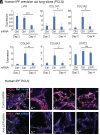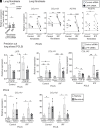Leukemia inhibitory factor (LIF) receptor amplifies pathogenic activation of fibroblasts in lung fibrosis
- PMID: 39636853
- PMCID: PMC11648669
- DOI: 10.1073/pnas.2401899121
Leukemia inhibitory factor (LIF) receptor amplifies pathogenic activation of fibroblasts in lung fibrosis
Abstract
Fibrosis drives end-organ damage in many diseases. However, clinical trials targeting individual upstream activators of fibroblasts, such as TGFβ, have largely failed. Here, we target the leukemia inhibitory factor receptor (LIFR) as an "autocrine master amplifier" of multiple upstream activators of lung fibroblasts. In idiopathic pulmonary fibrosis (IPF), the most common fibrotic lung disease, we found that lung myofibroblasts had high LIF expression, and the fibroblasts in fibroblastic foci coexpressed LIF and LIFR. In IPF, fibroblastic foci are the "leading edge" of fibrosis and a key site of disease pathogenesis. TGFβ1, one of the principal drivers of fibrosis, up-regulated LIF expression in IPF fibroblasts. We found that TGFβ1, IL-4, and IL-13 stimulations of fibroblasts require the LIF-LIFR axis to evoke a strong fibrogenic effector response in fibroblasts. In vitro antibody blockade of LIFR on IPF lung fibroblasts reduced the induction of profibrotic genes after TGFβ1 stimulation. Silencing LIF and LIFR reduced profibrotic fibroblast activation following TGFβ1, IL-4, and IL-13 stimulations. We also demonstrated that LIFR amplified profibrotic stimuli in precision-cut lung slices from IPF patients. These LIFR signals were transduced via JAK2, and STAT1 in IPF lung fibroblasts. Together, we find that LIFR drives an autocrine circuit that amplifies and sustains pathogenic activation of IPF fibroblasts. Targeting a single, downstream master amplifier on fibroblasts, like LIFR, is an alternative therapeutic strategy that simultaneously attenuates the profibrotic effects of multiple upstream stimuli.
Keywords: autocrine communication; fibroblasts; leukemia inhibitory factor; pulmonary fibrosis; receptors OSM-LIF.
Conflict of interest statement
Competing interests statement:C.P.H. reports consulting fees from AstraZeneca, Sanofi, and Takeda, outside of the submitted work. L.M.S. reports consulting: AstraZeneca, Lilly, Genentech. L.P.H. reports consulting: Boehringer Ingelheim, Pliant Therapeutics, Clario, and Abbvie Therapeutics. J.H.Y. reports consulting fees from Bridge Biotherapeutics and Genentech outside the submitted work. M.B.B. is a founder of Mestag Therapeutics and a consultant to GSK, Moderna, Third Rock Ventures, and 4F0 Ventures. J.W. and I.C. are employed by Abpro Corporation. H.N.N., Y.J., E.Y.K., and M.B.B. (lead) are co-inventors for PCT patent application (US2022/075673) concerning a method to treat fibrosis by targeting LIFR, the subject of this manuscript.
Figures





Update of
-
Leukemia inhibitory factor (LIF) receptor amplifies pathogenic activation of fibroblasts in lung fibrosis.bioRxiv [Preprint]. 2024 May 23:2024.05.21.595153. doi: 10.1101/2024.05.21.595153. bioRxiv. 2024. Update in: Proc Natl Acad Sci U S A. 2024 Dec 10;121(50):e2401899121. doi: 10.1073/pnas.2401899121. PMID: 38826450 Free PMC article. Updated. Preprint.
References
MeSH terms
Substances
Grants and funding
- P01 AI148102/AI/NIAID NIH HHS/United States
- R01 HL120393/HL/NHLBI NIH HHS/United States
- R01AR06370/HHS | NIH
- R01 HL167718/HL/NHLBI NIH HHS/United States
- R01 HL168138/HL/NHLBI NIH HHS/United States
- U01 HL120393/HL/NHLBI NIH HHS/United States
- R01AR073833/HHS | NIH | National Institute of Arthritis and Musculoskeletal and Skin Diseases (NIAMS)
- R01 AR073833/AR/NIAMS NIH HHS/United States
- R01 HL166992/HL/NHLBI NIH HHS/United States
- Bell Family Fund
- HHSN268201800001C/HL/NHLBI NIH HHS/United States
- R01 HL171213/HL/NHLBI NIH HHS/United States
- DA-827785/American Lung Association (ALA)
- R01 HL124233/HL/NHLBI NIH HHS/United States
- R01 HL117626/HL/NHLBI NIH HHS/United States
- P01AI148102/HHS | NIH
LinkOut - more resources
Full Text Sources
Research Materials
Miscellaneous

